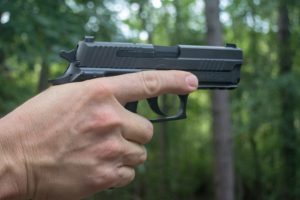I wish I’d been able to shed my pride and ask someone what to expect the first time I shot a semi-automatic pistol. Let’s say the episode ended prematurely and with a lot of my blood covering my gun, my shooting bag and the indoor range.
No, no one got shot. I just managed to cut the dickens out of my hand — so much so that it took a box of gauze pads and tape to stop the bleeding. How on earth did this happen? Well, let’s get into some things you can expect when shooting a semi-automatic pistol for the first time. If you pay attention to some basic instructions, unlike the way I did it, there will be no blood involved!
What Makes a Semi-Automatic?
Contrary to what breathless reporters might say, a semi-automatic pistol isn’t a “machine gun.” The “automatic” part of the name means that the design automates the routine steps of removing a spent cartridge case and loading a fresh cartridge. Like any other standard firearm, it fires only once for each trigger press.
While there are different design details for semi-automatic pistols, the basics are pretty much the same. When you fire, recoil energy wants to move backward, in the opposite direction of the bullet’s travel. So, clever engineers figured out how to put some of that recoil energy to good use and capture it for extracting the spent case, re-cocking the pistol and loading a new cartridge into the magazine. Nifty, huh?
From a functional perspective, you can expect that a semi-auto will fire each time you press the trigger until the magazine is empty. While models vary in terms of whether or how you need to cock it for the first shot, the operation is similar.

When you shoot a semi-automatic pistol one-handed, the firing hand thumb is already out of the way.
Slide Action!
So, we’ve figured out that these pistols re-cock themselves. Here’s how: The slide that surrounds the barrel will move backward as soon as the shot is fired because of the recoil energy. That moving slide grabs the spent case from the barrel and yanks it out. As the slide travels farther back, it either cocks the hammer or resets the striker, depending on the gun type. When the slide reaches the end of its travel, the recoil spring moves it back forward, scraping a fresh round from the top of the magazine and pushing it into the chamber.
Read the rest: What to Expect the First Time You Shoot a Handgun – USCCA








Got something to say?